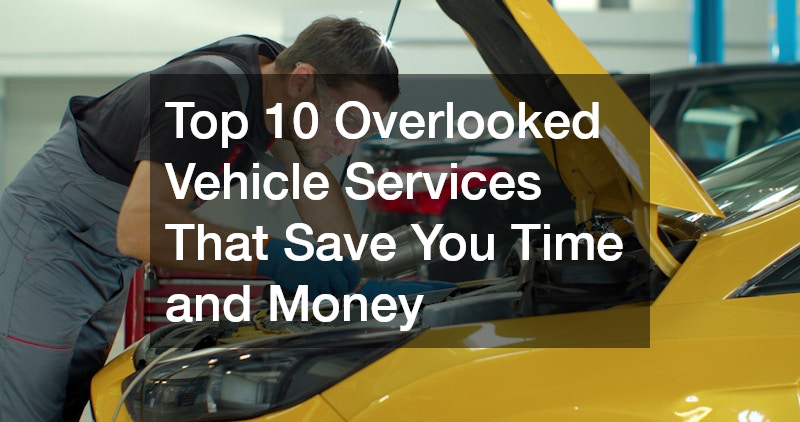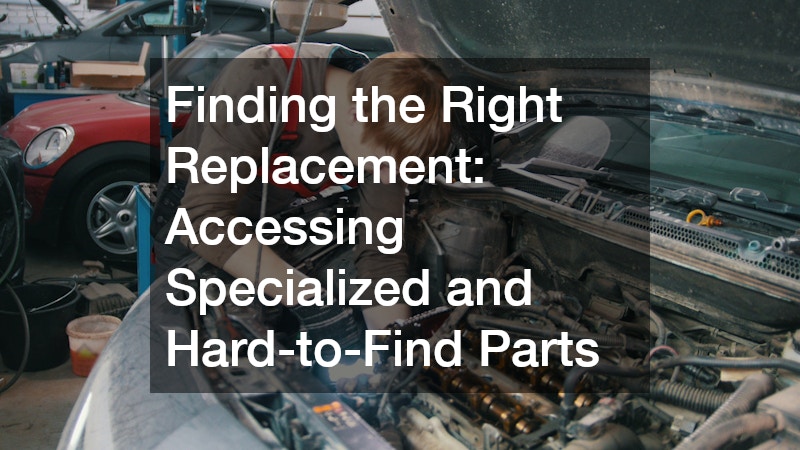
When most people think of car maintenance, they picture oil changes, tire rotations, and maybe a brake pad replacement every few years. But your vehicle is far more complex than that — it’s a system of interconnected parts that need consistent care to stay reliable.
Neglecting certain “minor” services can quietly wear down your vehicle’s performance, cost you thousands in surprise repairs, and even shorten its lifespan. The truth is, the most expensive repairs often come from ignoring the smallest warning signs.
In this guide, we’ll cover ten often-overlooked vehicle services that can make a huge difference in how your car, truck, or equipment performs. These are the services that help prevent breakdowns, improve safety, and stretch your dollar further — even when you think everything’s running fine.
Think of this list as a roadmap to smarter ownership. Whether you handle your own maintenance or rely on a trusted shop, these insights will help you prioritize services that protect your investment and keep your vehicle running smoothly for years to come.

1. Keep Your Ride Smooth: Why Regular Drive Maintenance Matters
Your vehicle’s drivetrain is what delivers power from the engine to the wheels. When any part of that system starts to fail — from gears to seals — you’ll feel it in the form of rough shifting, slipping, or strange vibrations.
Ignoring small signs of trouble is one of the most expensive mistakes drivers make. Early maintenance checks can prevent catastrophic breakdowns that lead to full transmission repair, which can easily cost several thousand dollars. What’s worse, many of these failures start with something simple, like running low on fluid or skipping a routine inspection.
A well-timed transmission repair doesn’t just fix immediate problems — it can restore smooth performance, improve fuel efficiency, and prevent related drivetrain wear. Addressing issues like slipping gears or fluid leaks early also reduces strain on your engine, helping the entire system last longer.
Key tips for protecting your drivetrain:
-
Check your transmission fluid every 30,000 miles or per your owner’s manual.
-
Look for signs like red or brown fluid, unusual burning smells, or delayed gear engagement.
-
Have your mechanic inspect seals and mounts for leaks at every major service interval.
-
Avoid aggressive driving habits — sudden stops and fast acceleration strain the system.
Some owners find it helpful to schedule a drivetrain inspection twice a year — once before summer heat and again before winter. Temperature changes can impact fluid viscosity, seals, and performance. A few preventive visits can make your car feel new again and delay major overhauls indefinitely.

2. Upgrade the Driving Experience with Professional Sound & Tech Installation
Upgrading your sound system isn’t just about better music — it’s also about modern functionality and safety. Professional car audio installation ensures that your sound system, Bluetooth connectivity, and other electronics integrate seamlessly with your vehicle’s existing systems.
DIY installations can lead to poor wiring, electrical shorts, and damaged components. A certified technician can ensure proper impedance matching and system calibration so that your sound quality improves without draining your battery or causing interference.
Why a professional install is worth it:
-
Avoids wiring mistakes that can short out your electrical system.
-
Maintains manufacturer warranties by preventing electrical damage.
-
Adds modern features like Apple CarPlay, Android Auto, or hands-free calling.
-
Enhances resale value — clean installs show care and attention to detail.
Bonus tip: ask your installer to soundproof your doors or trunk panels during the upgrade. This inexpensive add-on can reduce road noise dramatically and make even factory speakers sound high-end.
3. The Unsung Heroes of Vehicle Longevity: Skilled Technicians You Can Trust
Even the best parts won’t save your vehicle if they’re installed incorrectly. The real key to long-term reliability is finding auto mechanics who combine technical skill with integrity.
Many drivers jump from shop to shop looking for the cheapest quote — but that can backfire. Consistency matters because a mechanic familiar with your car’s history can spot early warning signs before they become problems.
Here’s how to evaluate your repair shop:
-
Ask for certifications. ASE or manufacturer-specific training shows commitment to quality.
-
Review labor warranties. A confident shop stands behind its work.
-
Check communication style. Do they explain issues clearly, or use jargon to upsell?
-
Look at the facility. Clean, organized shops reflect professionalism and pride.
A reliable mechanic is more than a repair person — they’re a partner in your vehicle’s long-term health. Building a relationship with a trusted shop can also lead to loyalty discounts, faster turnaround times, and peace of mind that your car is being cared for properly.

4. Beyond the Test Drive: The Role of Professional Diagnostics and Performance Checks
Many car owners assume that a quick spin around the block counts as a “test drive.” In reality, a proper road testing service is far more advanced. It’s a structured evaluation that replicates different driving conditions — highway speeds, stop-and-go traffic, and uphill loads — while capturing performance data.
This service can uncover hidden issues such as:
-
Steering alignment problems
-
Brake fade under repeated stops
-
Transmission hesitation under load
-
Poor acceleration or lagging response
Why it matters:
-
Early detection saves money by catching issues before they escalate.
-
Data from the test can confirm whether recent repairs were done correctly.
-
It helps establish a baseline performance profile for future comparisons.
A true professional test isn’t about “feel” — it’s about data. Shops offering advanced diagnostics often use OBD scanners, vibration sensors, and temperature readings to pinpoint subtle issues invisible to the naked eye. It’s the difference between guessing and knowing.
5. Heavy-Duty Maintenance: What Fleet Owners Overlook Most
Fleet owners and operators of commercial vehicles often focus on uptime — keeping trucks on the road to maintain revenue. However, skipping preventive maintenance for diesel engines is a costly gamble. Partnering with specialized diesel truck repair shops can dramatically improve performance and reliability.
Diesel engines operate under higher compression and load than gasoline engines, meaning minor issues can quickly turn catastrophic.
Essential maintenance tasks for diesel engines include:
-
Regular oil and fuel filter changes to prevent injector clogging.
-
Cleaning the Diesel Exhaust Fluid (DEF) system to avoid power loss.
-
Inspecting turbochargers for wear or oil leaks.
-
Monitoring glow plugs and block heaters before cold seasons.
Even small fleets benefit from digital maintenance tracking. Modern repair shops often offer fleet management software that reminds owners when each vehicle is due for service, helping businesses plan ahead and minimize downtime.

6. Finding the Right Replacement: Accessing Specialized and Hard-to-Find Parts
If you own a European, vintage, or imported vehicle, finding reliable replacement parts can feel like a scavenger hunt. That’s where specialized providers such as Steyr part services come in — offering authentic or high-quality compatible components that general parts stores often can’t supply.
Using improper or counterfeit parts can lead to fitment issues, reduced performance, and even safety hazards.
How to ensure you’re sourcing the right parts:
-
Verify supplier authenticity and part numbers.
-
Ask your repair shop whether they have direct supplier relationships.
-
Consider OEM or certified aftermarket options for balance between cost and quality.
-
Request documentation and warranties for all specialized components.
Even if you don’t drive a rare car, knowing where to get trusted parts pays off. Specialty suppliers are often faster and more reliable than big-box stores — especially when you’re dealing with performance upgrades or hard-to-find mechanical assemblies.
7. Don’t Get Stranded: How Regular Trailer and Equipment Checks Prevent Breakdowns
Whether you haul equipment, boats, or work materials, your trailer’s reliability directly affects your safety and productivity. Neglecting trailer parts like brakes, bearings, and electrical connections can lead to dangerous situations on the highway.
Regular inspection checklist:
-
Hitch & Coupler: Ensure secure connections and proper locking.
-
Lights & Wiring: Check for shorts, corrosion, and loose connectors.
-
Bearings: Grease or replace at least once per year.
-
Brakes: Inspect pads, drums, and actuators for wear.
-
Tires: Look for cracks, uneven wear, or dry rot.
For business owners who rely on trailers, scheduling inspections alongside vehicle service appointments saves time and ensures nothing slips through the cracks. A well-maintained trailer doesn’t just protect your cargo — it protects your reputation.
8. Getting Ready for Winter: Prepping Your Vehicle and Equipment
Cold weather is tough on every part of a vehicle — batteries weaken, fluids thicken, and metal contracts. If your vehicle or business equipment involves snow plowing, preparing before the first storm can make the difference between smooth operation and frustrating downtime. A few hours of preventive maintenance now can save days of lost productivity (and expensive mid-storm repairs) later.
Essential winter-prep steps:
-
Inspect hydraulic systems: Replace fluid and check for leaks or cracked hoses. Cold temperatures can cause seals to shrink and fail.
-
Examine cutting edges and mounts: Worn blades and loose connections reduce efficiency and can cause uneven plowing or equipment strain.
-
Test lighting and electrical connections: Visibility is critical in snow conditions—check headlights, work lights, and connectors for corrosion.
-
Check tire pressure and antifreeze levels: Temperature drops can drastically affect both. Keep a gauge in your vehicle for on-the-spot adjustments.
-
Apply protective coatings: Use anti-corrosion sprays on plow frames, mounts, and exposed metal to combat salt and moisture damage.
Also, don’t forget to winterize your personal car. Replace worn wiper blades, test your heater core, and confirm that defrost vents are functioning properly. Stock an emergency kit with blankets, gloves, snacks, jumper cables, and sand or kitty litter for traction.
For fleet operators or contractors, create a winter readiness checklist and schedule inspections in late fall. Keeping spare parts—like hydraulic hoses, cutting edges, and fuses—on hand can prevent work delays when supply chains tighten during storms. The goal is simple: stay ready, stay safe, and stay moving all winter long. With the right preparation, your vehicle and snow plowing equipment will handle whatever the season brings with confidence and reliability.
9. Small but Mighty: Maintaining Your Light Utility and Leisure Vehicles
Golf carts, utility carts, and other small electric vehicles often get overlooked — until they stop working at the worst possible time. Whether used on a campus, resort, or residential property, these vehicles benefit greatly from regular golf cart service.
Common maintenance tasks include:
-
Checking and cleaning battery terminals to prevent corrosion.
-
Inspecting brakes, steering, and suspension for wear.
-
Ensuring proper tire inflation for smooth operation.
-
Lubricating moving components to avoid squeaks and stiffness.
-
Testing chargers and cables for safe connections.
For communities and businesses that rely on electric carts daily, scheduling seasonal service can also prevent downtime during events or peak hours. Regular service helps preserve battery health, improves safety, and can even extend the life of your investment by several years.
10. Stay Cool Year-Round: The Importance of Proper Climate System Care
Few things make driving more uncomfortable than a failing air conditioning system, especially during peak summer or a humid spring day. But the climate system does more than keep you comfortable — it also helps clear your windshield, filter dust and pollen, and prevent mold buildup in your vents.
Regular inspections and professional AC repair ensure that small leaks, compressor wear, and refrigerant loss don’t escalate into expensive problems.
Signs your AC needs attention:
-
Air blows weakly or inconsistently.
-
Strange odors when the system starts up.
-
Unusual noises when turning the AC on or off.
-
Windows fog up faster than usual.
Maintenance tips:
-
Run your AC periodically during the winter to circulate refrigerant and lubricate seals.
-
Replace cabin air filters annually.
-
Have a professional check refrigerant levels and pressure once a year.
Proper AC maintenance also boosts fuel efficiency — your compressor won’t have to work as hard, which means less engine load and better mileage. It’s one of the simplest ways to improve comfort, safety, and performance at once.
Preventive maintenance is one of the smartest financial moves any vehicle owner can make. The services most people overlook — from drivetrain care to small equipment maintenance — are often the ones that prevent massive, costly breakdowns.
By paying attention to these ten areas, you’ll enjoy smoother rides, better performance, and fewer surprises at the repair shop. It’s not about spending more on your vehicle; it’s about spending smarter.
Whether you drive a compact sedan, a diesel truck, or even a golf cart, the same principle applies: proactive care always pays off. Keep a maintenance checklist, build a relationship with a trusted technician, and give your vehicle the attention it deserves — because reliability isn’t luck; it’s maintenance.



